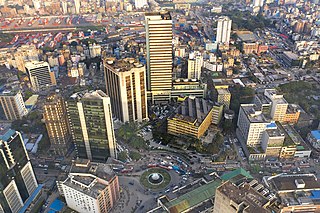Economy of Bangladesh
Economy of Bangladesh
The economy of Bangladesh is a major developing market economy.[44] As the second-largest economy in South Asia,[45][46] Bangladesh's economy is the 33rd largest in the world in nominal terms, and 25th largest by purchasing power parity. Bangladesh is seen by various financial institutions as one of the Next Eleven. It has been transitioning from being a frontier market into an emerging market. Bangladesh is a member of the South Asian Free Trade Area and the World Trade Organization. In fiscal year 2021–2022, Bangladesh registered a GDP growth rate of 7.2% after the global pandemic.[47] Bangladesh is one of the fastest growing economies in the world.
Economy of
Bangladesh Motijheel C/A, the downtown of Dhaka
Motijheel C/A, the downtown of Dhaka
Currency
Bangladeshi taka (BDT, ৳)
Fiscal year
1 July – 30 June
Trade organizations
SAFTA, SAARC, BIMSTEC, WTO, AIIB, IMF, Commonwealth of Nations, World Bank, ADB, Developing-8
Country group
Statistics
Population
169,800,000 (2022)[3]
GDP
GDP rank
GDP growth
GDP per capita
GDP per capita rank
GDP by sector
(FY2020)[11]
Inflation (CPI) 9.89% (January 2024)[12]
9.89% (January 2024)[12]
Population below poverty line
- 18.7% (2024)[13]
 5.6% living in extreme poverty (2024)[13]
5.6% living in extreme poverty (2024)[13]- 6.5% (rural) ; 3.8% (urban)
Gini coefficient 31.8 medium (2022)[14]
31.8 medium (2022)[14]
Human Development Index
Labor force
Labor force by occupation
- Agriculture: 40.6%
- Industry: 20.4%
- Services: 39.6%
- (2017 est.)[19]
Unemployment
 3.53%
3.53%- (2024)[20]
Main industries
- TextilesPharmaceutical ProductsElectronicsShipbuildingAutomotiveBicycleLeatherJuteGlassPaperPlasticFood and BeveragesCementTeaRiceNatural Gas and Crude PetroleumIron and Steel
External
Exports
Export goods
Cotton textiles and knitwear,[25][26] jute and jute goods,[25][26] fish and seafood,[26] leather and leather goods, home textiles, pharmaceuticals, processed food,[27] plastics, bicycles[26]
Main export partners
 Germany(+) 16%
Germany(+) 16% United States(+) 15.2%
United States(+) 15.2% United Kingdom(+) 7.41%
United Kingdom(+) 7.41% Spain(+) 7.17%
Spain(+) 7.17% Poland(+) 5.552%
Poland(+) 5.552% France(+) 4.2%
France(+) 4.2% Netherlands(+) 3.55%
Netherlands(+) 3.55% Italy(+) 3.36% (2020)[28][29]
Italy(+) 3.36% (2020)[28][29]
Imports
- $70.1 billion (2024)[30]
Import goods
Liquified natural gas, crude oil and petroleum, machinery and equipment, chemicals, cotton, foodstuffs
Main import partners
 China(+) 21.5%
China(+) 21.5% India(+) 12.2%
India(+) 12.2% Singapore(+) 9.2%
Singapore(+) 9.2% European Union(+) 6.2%
European Union(+) 6.2% Hong Kong(+) 5.5%
Hong Kong(+) 5.5%- Other 45.3%[31]
FDI stock
Gross external debt
 $110 billion
$110 billion- (F.Y. 2024)[36]
Public finances
Government debt 40.7% of GDP (November 2021)[37]
40.7% of GDP (November 2021)[37]
Budget balance
−3.2% of GDP (2017 est.)[33]
Revenues ৳433000 crore (US$40 billion) (2022-2023)[38]
৳433000 crore (US$40 billion) (2022-2023)[38]
Expenses ৳678064 crore (US$63 billion) (2022-2023)[38]
৳678064 crore (US$63 billion) (2022-2023)[38]
Credit rating
List of ratings
- Standard & Poor's:[39]
- BB− (Domestic)
- BB− (Foreign)
- BB− (T&C Assessment)
- Outlook: Negative
- Moody's:[40][41]
- B1
- Outlook: Stable
- Fitch:[42]
- BB−
- Outlook: Negative
Foreign reserves $20 billion (2024)[43] (63rd)
$20 billion (2024)[43] (63rd)
Main data source: CIA World Fact Book
All values, unless otherwise stated, are in US dollars.
Industrialisation in Bangladesh received a strong impetus after the partition of India due to labour reforms and new industries.[48] Between 1947 and 1971, East Pakistan generated between 70% and 50% of Pakistan's exports.[49][50] Modern Bangladesh embarked on economic reforms in the late 1970s which promoted free markets and foreign direct investment. By the 1990s, the country had a booming ready-made garments industry. Remittances from the large Bangladeshi diaspora became a vital source of foreign exchange reserves. Agriculture in Bangladesh is supported by government subsidies and ensures self-sufficiency in food production.[51][52] Bangladesh has pursued export-oriented industrialisation.[53][54]
Bangladesh experienced robust growth after the pandemic with macroeconomic stability, improvements in infrastructure, a growing digital economy, and growing trade flows.[55] Tax collection remains very low, with tax revenues accounting for only 7.7% of GDP.[56] Bangladesh's banking sector has a large amount of non-performing loans or loan defaults, which have caused a lot of concern.[56][57] The private sector makes up 80% of GDP.[58][59] The Dhaka Stock Exchange and Chittagong Stock Exchange are the two stock markets of the country.[60] Most Bangladeshi businesses are privately owned small and medium-sized enterprises (SME) which make up 90% of all businesses.[61]
Economic history
Last edited 3 days ago by GünniX
RELATED ARTICLES
- Economy of Cambodia
- Textile industry in Bangladesh
- Regional economic sector in South Asia
- Economy of South Asia
- Content is available under CC BY-SA 4.0 unless otherwise noted.
- Privacy policy
- Terms of Use
- Desktop













































